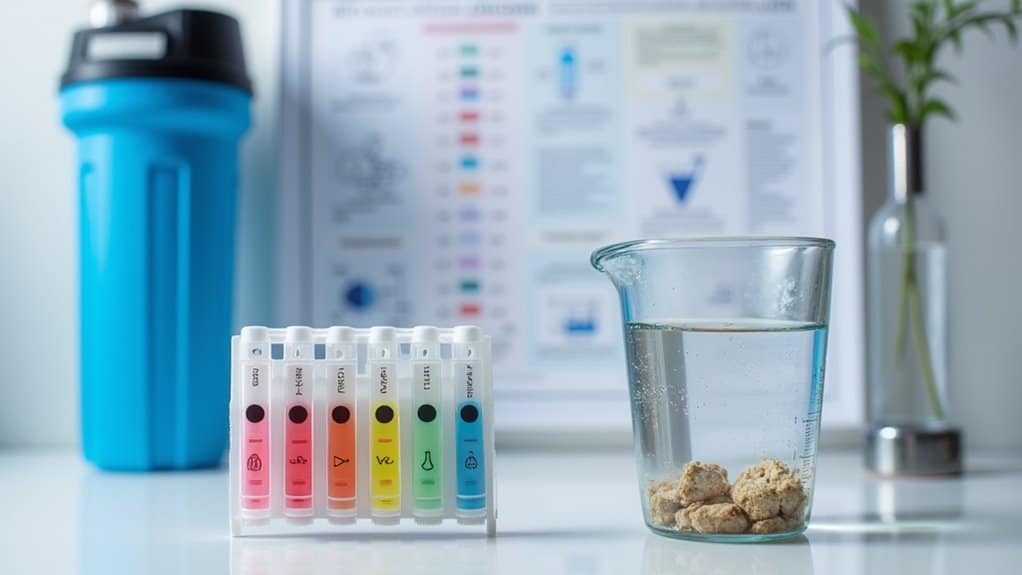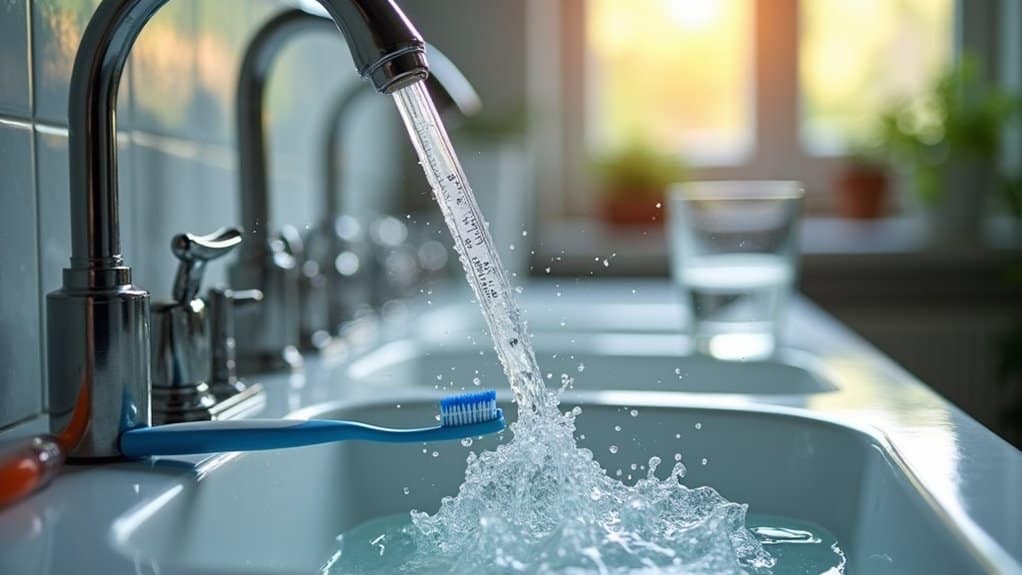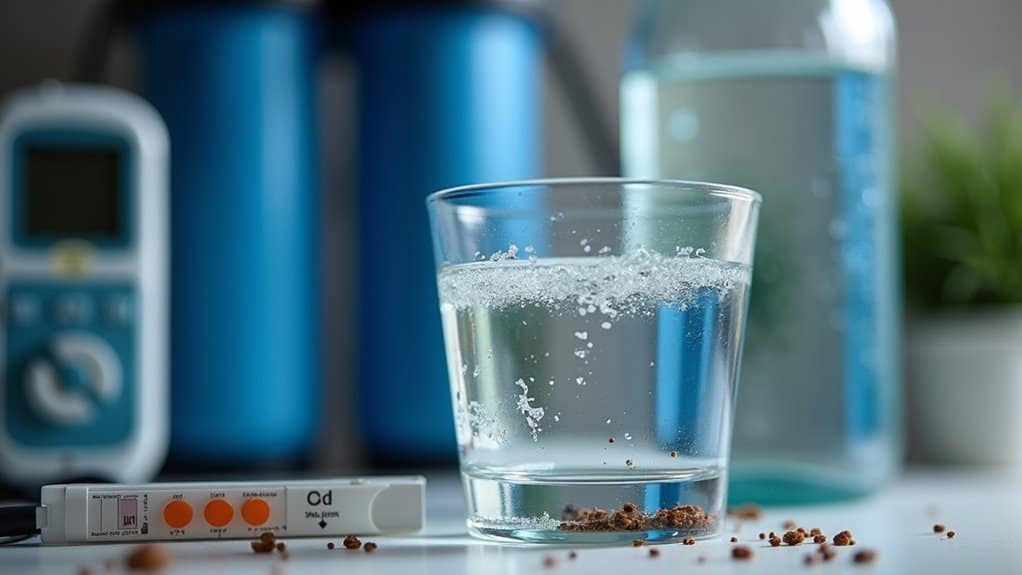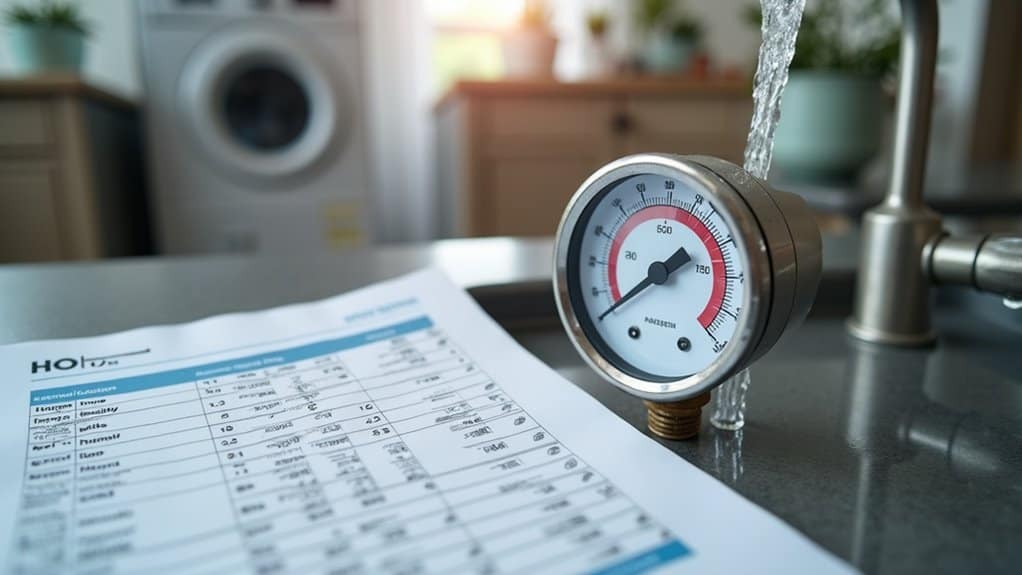Standard water tests often mislead homeowners about softener sizing by focusing solely on calcium and magnesium levels while ignoring critical factors like peak flow demands and non-hardness contaminants. These tests typically measure daily averages instead of accounting for simultaneous water usage patterns in your household. Iron, manganese, and silica can foul resin beds and reduce effectiveness. Understanding these limitations will help you select a system that truly meets your home’s unique water treatment needs.
Key Takeaways
- Standard water tests often miss contaminants like iron and manganese that can reduce softener effectiveness and capacity.
- Consumer test strips lack precision and only measure up to 425 ppm, potentially underestimating your actual hardness level.
- Water hardness calculations typically ignore peak usage periods when multiple fixtures operate simultaneously.
- Standard sizing assumes 80-82 gallons per person daily, but actual household patterns may require larger capacity systems.
- High TDS from non-hardness minerals can skew readings and lead to undersized softener systems.
The Hidden Limitations of Standard Water Hardness Tests

While homeowners routinely rely on water hardness tests to determine softener needs, standard testing methods harbor significant limitations that can lead to improper system sizing.
Most consumer-grade test strips only measure within narrow ranges (0-425 ppm) and lack precision required for accurate calculations.
Test methods often fail to distinguish between carbonate and non-carbonate hardness—a crucial distinction when selecting between precipitation or ion exchange treatments.
Further complications arise when iron or manganese exceeds 0.3 mg/L, as these contaminants foul resin beds, rendering standard sizing formulas inadequate.
Readings may also misrepresent hardness when high TDS stems from non-hardness minerals like sulfates or chlorides. This undermines effective ion exchange capacity, preventing proper sizing calculations based on the system’s ability to process hardness minerals.
How Your Family’s Water Usage Patterns Can Invalidate Test Results

Even when water hardness tests provide accurate mineral content readings, they fail to account for one crucial variable: your family’s actual water usage patterns.
Standard calculations assume 80-82 gallons per person daily, but reality differs dramatically. Morning routines create peak demand periods when multiple fixtures operate simultaneously, overwhelming undersized systems. Additionally, the household size directly influences the total capacity needed for effective softening.
Your household’s unique habits—frequent laundry, extended showers, irrigation systems—significantly impact total consumption. Utilizing customer support resources can help you better understand how your specific usage affects water softener performance.
Seasonal variations further complicate sizing. Summer months often see 2-3× normal usage for gardens and pools, while standard tests reflect only annual averages. This seasonal spike in water demand can exacerbate existing challenges, especially in larger families.
Multi-person households face additional challenges as overlapping water needs create demand spikes that cookie-cutter sizing formulas simply can’t address.
Beyond Calcium and Magnesium: The Contaminants Tests Often Miss

Standard water hardness tests focus primarily on calcium and magnesium levels, providing an incomplete picture of your water’s actual composition. These tests often miss critical contaminants that significantly impact softener sizing and performance. Consulting with local water experts can help ensure your water softener is correctly sized to address your unique household needs. Additionally, neglecting to account for misjudged water hardness can lead to ineffective softening and increased maintenance costs.
| Contaminant | Impact | Testing Need |
|---|---|---|
| Iron/Manganese | Binds to resin (1 ppm = 4 gpg equivalent) | Convert to gpg for calculations |
| Silica/TDS | Encrusts resin beads, reducing efficiency | May require RO post-treatment |
| Heavy Metals | Accelerates resin attrition, affects capacity | Often excluded from standard tests |
We’ve observed that sulfates, phosphates, and other non-hardness minerals frequently go undetected yet dramatically alter system requirements. These overlooked contaminants can reduce your softener’s lifespan and effectiveness.
Peak Flow Demands vs. Daily Averages: Sizing for Real-World Performance

When sizing water softener systems, the distinction between peak flow demands and daily averages represents one of the most critical yet overlooked factors in system performance.
Standard water tests report daily hardness and average consumption, but fail to capture those crucial moments when multiple fixtures operate simultaneously. Your family taking morning showers while the dishwasher runs creates demand spikes of 12-15 GPM that overwhelm systems sized for averages. This can lead to significant cost savings by ensuring your softener is properly sized to handle peak usage.
This forces water through resin beds at excessive pressures, compressing the media and allowing hardness breakthrough.
We recommend multi-tank demand flow systems that handle peak usage without the 15-25 PSI pressure drops common in undersized units. Demand flow softening enables tanks to work side by side, effectively managing fluctuating water flow rates throughout the day.
Frequently Asked Questions
How Often Should I Retest My Water After Installing a Softener?
We recommend retesting quarterly for high-usage homes, annually for well water, and every 2-3 years for municipal systems. Always retest after household size changes, system adjustments, or unexpected hardness increases.
Can Rental Softeners Handle My Home’s Specific Water Chemistry?
We’ve found rental softeners typically lack customization for specific water chemistries, often missing iron, manganese, and pH variations while using outdated regeneration technology that can’t adapt to your home’s unique contamination profile.
Will Softening Affect My Water-Using Appliances’ Warranties?
We’ve found that water softening typically doesn’t void appliance warranties unless it directly causes damage. Most manufacturers focus on mechanical failures rather than water quality in their warranty terms.
How Do Seasonal Changes Impact My Softener’s Regeneration Schedule?
We see summer water usage spikes dramatically accelerate resin saturation, forcing more frequent regenerations. Your softener will cycle less during winter’s reduced demand, maintaining efficiency through these predictable seasonal fluctuations.
What Hidden Costs Emerge From Incorrectly Sized Water Softeners?
We’ve observed incorrectly sized water softeners generate substantial hidden costs: premature resin failure, excessive salt consumption, increased water bills, environmental remediation expenses, and accelerated plumbing system deterioration from inconsistent hardness removal.
Conclusion
We’ve demonstrated why conventional water hardness metrics often lead to undersized softener systems. While standard tests measure calcium and magnesium concentrations, they fail to account for actual household consumption patterns, peak flow requirements, and non-hardness contaminants that impact system performance. For optimal water treatment, we recommend comprehensive testing that analyzes temporal usage variations and all potential interference factors before selecting softener capacity and configuration.

Craig “The Water Guy” Phillips is the founder of Quality Water Treatment (QWT) and creator of SoftPro Water Systems.
With over 30 years of experience, Craig has transformed the water treatment industry through his commitment to honest solutions, innovative technology, and customer education.
Known for rejecting high-pressure sales tactics in favor of a consultative approach, Craig leads a family-owned business that serves thousands of households nationwide.
Craig continues to drive innovation in water treatment while maintaining his mission of “transforming water for the betterment of humanity” through transparent pricing, comprehensive customer support, and genuine expertise.
When not developing new water treatment solutions, Craig creates educational content to help homeowners make informed decisions about their water quality.


